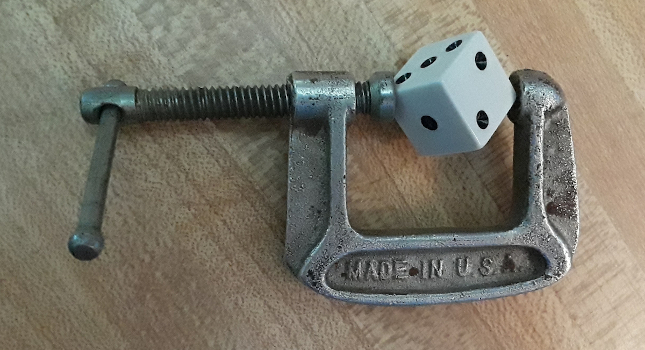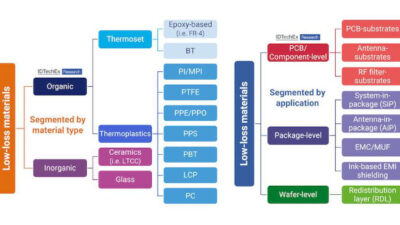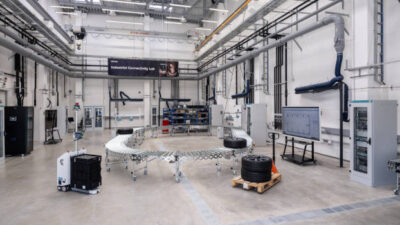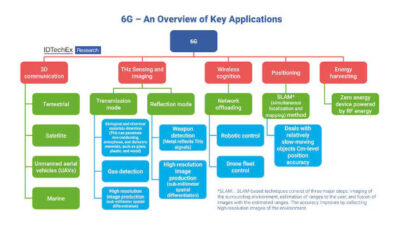Are your industrial wireless local area networks up to date? Industrial communications are taking another leap forward with IEEE 802.11ax and 5G wireless technologies. Be sure to evaluate the status of industrial wireless LAN (iWLAN) technologies.

Learning Objectives
- Closing wireless latency gaps can achieve real-time wireless communications.
- Industrial wireless is more than hotspots.
- IEEE 802.11ax and 5G boost future network communication options.
The steady evolution of fast, deterministic and reliable wireless networks in industrial environments has been a critical driver behind the realization of Industry 4.0 and industrial Internet of things (IIOT) concepts over the past decade. Industrial communications are taking another leap forward with IEEE 802.11ax and 5G wireless technologies available for industrial environments. That’s why it’s a good time to evaluate the status of industrial wireless LAN (iWLAN) technologies supporting production plants and their associated logistics and warehouse facilities. [LAN stands for local area network.]
Industrial engineers working in these operational technology (OT) environments should work together with their enterprise information technology (IT) counterparts to develop wireless modernization roadmaps to ensure maximum performance, reliability, and security in coming years. The collaboration between OT and IT teams is critical because data can be used much differently in industrial environments than in enterprise ones. This primer on industrial wireless communications intends to help OT and IT professionals better collaborate on those roadmaps.
It’s been more than 20 years since the IEEE first ratified the original IEEE 802.11 standard, with IEEE 802.11a,b, and g versions quickly following, all mostly for office and home applications under the “WiFi” trade name. Although some plant engineers may have trialed these versions in industrial applications — mostly with hopes of reducing cabling costs and gaining floorplan configuration flexibility — the deterministic inadequacies of these early WiFi versions became apparent quickly in OT networks.
Closing wireless latency gaps to achieve real-time communications
The biggest shortcoming was data transmission latency — mostly from data collisions within the iWLAN’s shared medium that require data to be retransmitted. Too many retransmissions of the same message can cause an expiration of watchdog timers that monitor the response time of control and safety data traffic between sensors and programmable logic controllers (PLCs), leading to nuisance faults that can disrupt production.
It can be especially problematic when roaming is involved. That’s because the moving client is transitioning its wireless communications from one access point (AP) to the next. The time required to re-associate to the new AP, which can be even longer if it must go through an AP controller, can similarly lead to communication faults that compromise the effectiveness of control and safety systems. These delays may even influence controls engineers to increase their watchdog timers to accommodate the longer latency, ultimately sacrificing their control and safety standards to keep production running.
The introduction of IEEE 802.11n in 2009 and IEEE 802.11ac in 2014 helped changed that. Transmission speeds of each increase by orders of magnitude over their previous standards and specific technology developments helped ensure greater determinism for OT applications—with latencies as low as 17 milliseconds.
Such technology reduces, fixes, and distributes evenly the polling cycles among clients enough to minimize latencies and allow for much faster roaming times. A variation of this protocol was developed especially for continuously moving nodes like those aboard AGVs and cranes, to further boost performance and reduce roaming times to under 50 ms.
Industrial WLANs—much more than simple WiFi hotspots
But establishing iWLANs takes more tech-savvy than setting up WiFi in a home, office or café. Hotels, airports and municipalities may be more complex undertakings because of their scale, but in a production plant wireless connectivity must meet much more rigorous demands. Here are two other differences:
- Fail-safe reliability: Data loss or corruption during transmission in non-industrial environments usually isn’t critical, since the data can always be retransmitted usually without any detectable impact by the recipient. But in industrial environments, failed data transmissions can compromise process and safety controls, leading to plant downtime, quality issues and injuries.
- Radio interference, attenuation, and reflection: Non-industrial environments tend to lack the different sources of radio frequency (RF) interference, reflective objects, and attenuation that industrial environments have: large, odd-shaped metal machinery, ductwork, metal decking, and aluminum rolling doors can reflect RF waves; thick concrete walls or materials stored in warehouse racks that can block them; and a range of other sources of radio signaling—RFID, neighboring industrial WLANs and office WLANs, to name a few.
IEEE 802.11ax and 5G boost future network communication options
Given the growth in IoT and IIoT device numbers and density, IEEE 802.11ax shifts the WiFi paradigm from theoretical peak data speeds to overall network capacity. To be sure, IEEE 802.11ax increases speeds from IEEE 802.11ac up to 10 Gbps, a 37% boost. But using an orthogonal frequency-division multiple access (OFDMA) borrowed from 4G LTE technology, the new IEEE 802.11ax standard improves spectral efficiencies substantially—enough to support the communications of a million devices per square kilometer.
Industrial 5G is another animal entirely. It opens the door to the comprehensive, wireless networking of all kinds of new applications in production, maintenance, and logistics. High data rates, reliable and powerful broadband transmission, and ultra-short latencies will boost efficiency and flexibility in industrial value creation significantly, although all of these benefits will not be available simultaneously.
Industrial 5G raises a lot of questions on how the new communication standard can be best implemented. Some automation companies have 5G research teams working with standards bodies to bring customers 5G when it’s ready for full deployment in industrial environments. In the meantime, sticking with IEEE 802.11 WiFi standards, particularly IEEE 802.11n, ac and ax, is recommended, depending on the wireless industrial application.
Time to update your industrial WLANs?
Given that many iWLANs in use today may have been deployed with IEEE 802.11a, b, g or n technology that is in some cases now a decade old, plant engineers should consider evaluating their current networks for modernization—or at least a modernization roadmap—in concert with industrial networking experts and their enterprise IT counterparts.
While 5G and IEEE 802.11ax are the future directions of wireless, IEEE 802.11ac and IEEE 802.11n are capable today of providing the fast throughput and low latencies industrial applications require.
For example, IEEE 802.11ac can provide the throughput needed for video applications, while IEEE 802.11n is valuable for industrial MIMO (Multiple Input, Multiple Output) applications. The latter can support mobile automated guide vehicles and overhead cranes by helping to deal with ever-changing RF reflections as one moves through a plant.
In addition, where deterministic communications such as control traffic and safety must be prioritized, iWLANs can be further optimized using technology that adds determinism to industrial wireless communications.
Low latencies can improve the performance of edge computing, workers assisted by virtual and augmented reality (VR/AR) technologies, even greater mobility in plant equipment and machines, and autonomous machines and logistics. Of course, the greater sophistication of these applications will require more sophisticated RF engineering, making careful site surveys and other best practices even more critical to successful deployments.
Ford Cheeseman is automation networking consultant, Siemens. Edited by Mark T. Hoske, content manager, Control Engineering, CFE Media, [email protected].
KEYWORDS: Industrial wireless, 5G, IEEE 802.11 wireless
CONSIDER THIS
Where do you need real-time industrial wireless communications?
ONLINE extra
Adding determinism to industrial wireless communications.
Specific technology developments, such as the Siemens Industrial Point Coordination Function (iPCF), helped ensure greater determinism for OT applications—with latencies as low as 17 milliseconds.
For example, iPCF reduces, fixes, and distributes evenly the polling cycles among clients enough to minimize latencies and allow for much faster roaming times. A variation of this protocol—iPCF-MC—was developed especially for continuously moving nodes like those aboard AGVs and cranes, to further boost performance and reduce roaming times to under 50ms.
Siemens has a dedicated 5G research team working with standards bodies to bring customers 5G when it’s ready for full deployment in industrial environments.
In addition, where deterministic communications such as control traffic and safety must be prioritized, iWLANs can be further optimized using Siemens iPCF technology.
Get more information about Siemens industrial Point Coordination Function (iPCF) in a video on this page.



